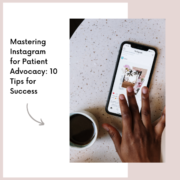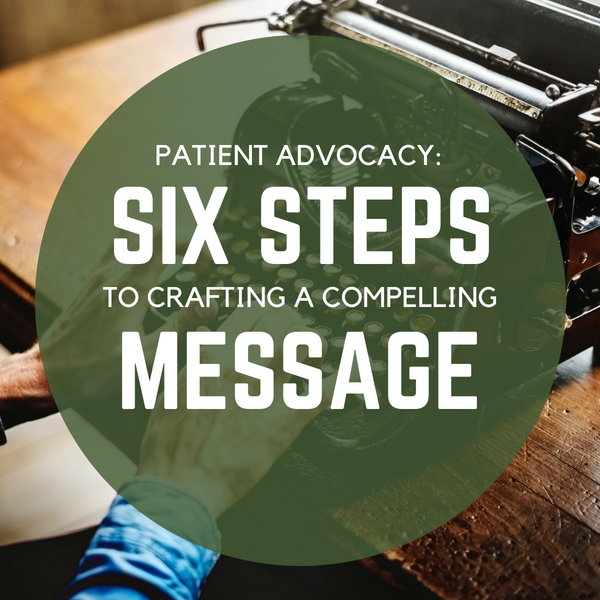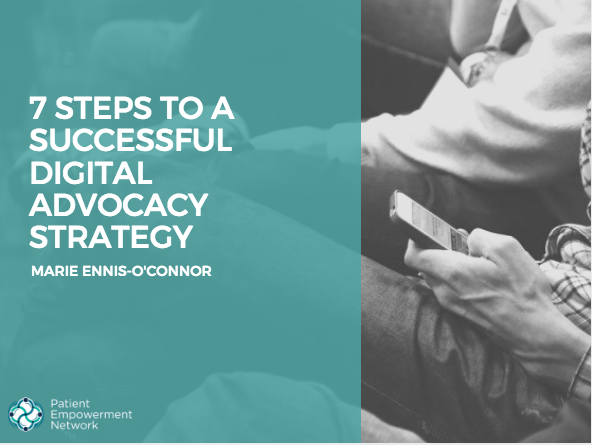Mastering Instagram for Patient Advocacy: 10 Tips for Success
Boasting more than two billion active users, Instagram provides an excellent platform for patient advocates to reach a wide audience and inspire change.
Here are 10 tips to help you achieve more on Instagram and make the most of your advocacy efforts.
1. Craft A Compelling Profile
- Your Instagram profile is an essential part of establishing your digital identity and expressing your advocacy mission. Visitors and potential followers get their first impression from your profile.
- Choose a profile picture that’s easily recognizable and relates to your advocacy. It could be your logo or a photo that represents your cause. Ensure that it’s clear and easily identifiable even in a small thumbnail.
- Your username, also known as your handle, should ideally be related to your advocacy and easy to remember. If your exact name is taken, consider adding an underscore or a simple modifier to make it unique while still relevant.
- Your bio is a brief space to explain your cause and what you stand for. Use clear and concise language to convey your mission. Incorporate relevant keywords related to your advocacy in your bio. This can help your profile appear in search results when users look for related topics. You might also include a call-to-action or a link to a website or donation page if applicable.
- Strategically use emojis to enhance your bio. Emojis can add visual appeal and personality to your profile while conveying emotions and messages succinctly.
- Instagram allows you to have one clickable link in your bio. If you have a website, blog, donation page, or a specific landing page for your cause, make sure to include it here. You can also use tools that allow you to create link trees to direct users to multiple destinations. If you’re open to inquiries, consider including a contact email or other relevant contact information in your bio.
- Highlight specific accomplishments, milestones, or awards that you or your advocacy have achieved. These could include successful campaigns, collaborations, events, media coverage, or any other noteworthy achievements.
- As your advocacy work evolves, make sure to update your bio accordingly. Whether it’s mentioning recent accomplishments, upcoming events, or new partnerships, keeping your bio current ensures that visitors are getting the latest information about your cause.
2. Share Stories
- Sharing authentic stories – your own or others – is a powerful way to connect with your audience on Instagram and convey the impact of your advocacy.
- Whenever possible, let the individuals whose stories you’re sharing speak in their own words. This adds authenticity and allows your audience to connect directly with the emotions and experiences of those affected.
- When sharing others’ stories, ensure that you have obtained proper consent from the individuals involved. Respect their privacy and avoid sharing sensitive or identifying information without permission.
- Showcase a diverse range of stories and voices. Different perspectives help your audience better understand the breadth and depth of the impact your advocacy cause has on various individuals and communities.
- Create a comprehensive storytelling experience with both visual and written elements. Use a mix of images, videos, and graphics to complement the narrative in your captions. Visual elements can evoke emotions and help your audience better understand the individuals behind the stories.
3. Optimize Visual Content
- Optimizing your visual content is essential for grabbing attention and effectively conveying your advocacy message. Visual content is more likely to be shared and remembered, helping you reach a wider audience.
- Use clear, high-resolution images that are relevant to your cause.
- Use visuals to evoke emotions that resonate with your cause. Happy, inspiring, or even somber imagery can effectively communicate the mood you want to convey.
- Overlay impactful quotes, statistics, or brief messages onto images. Quotes can capture the essence of your advocacy and inspire your audience to take action or reflect on their own experiences.
- Use simple animations to add movement and engagement to your posts. Animated graphics can be a creative way to share information.
- Complex information and statistics can be more digestible when presented in the form of infographics. Create informative graphics that break down facts, figures, and data related to the condition, treatment options, or advocacy goals.
- Instagram’s carousel feature allows you to share multiple images or videos in a single post. Use this to showcase various aspects of your advocacy, or present different perspectives.
4. Create a consistent visual identity
- Maintaining a consistent color palette and visual style on Instagram can significantly enhance your profile’s overall appeal and recognition. Choose a primary color or a small palette of complementary colors. This helps in creating a cohesive and visually appealing feed.
- Create templates for quotes, statistics, or announcements that incorporate your color palette. You can also use filters that align with your brand’s aesthetics.
- If you use filters to enhance your images, choose a filter or set of filters that align with your visual identity. Consistently applying these filters gives your profile a polished and harmonious look.
- Consider the overall aesthetic of your Instagram feed. Plan how your posts will look when they are viewed together on your profile. Plan your grid layout in advance to ensure a visually pleasing arrangement of posts.
- Design custom covers for your story highlights that follow your color palette and style. This adds a polished and consistent look to your profile.
5. Use Hashtags Strategically
- Using relevant and strategic hashtags can significantly expand the reach of your advocacy content on Instagram. Use tools like Instagram’s search function, and hashtag generator tools to discover relevant and trending hashtags
- Include a mix of popular and niche hashtags in your posts. While popular hashtags can expose your content to a larger audience, niche hashtags help you connect with a more targeted and engaged community.
- If your advocacy efforts are local or tied to a specific event or region, use location-based hashtags to reach individuals in that area.
- While it’s tempting to use a lot of hashtags, focus on quality over quantity. Include around 5-10 relevant and well-chosen hashtags per post to avoid appearing spammy.
- Don’t forget to use hashtags in your Instagram Stories. While they’re not as common here, they can still increase the discoverability of your stories.
- Change your hashtags periodically to avoid being seen as repetitive by Instagram’s algorithms. This can also help you reach new audiences.
- Regularly review the performance of the hashtags you’re using. See which ones are driving the most engagement and reach. Adjust your hashtag strategy based on this data.
6. Leverage Story Highlights
- Instagram Story Highlights can be a great resource for patient advocacy. Create separate Story Highlight categories for different aspects of your advocacy. For example, you could have highlights for patient stories, educational resources, events, news updates, and more.
- If you’re hosting events, campaigns, or awareness drives, use a dedicated Highlight to keep your audience informed about the latest updates, schedules, and details.
- Highlight the milestones and achievements of your patient advocacy efforts. This can include successful campaigns, partnerships, media coverage, and more.
- Keep your followers informed about policy changes, research developments, or advancements in medical treatments by creating a highlight dedicated to advocacy updates.
- Compile a highlight with answers to common questions about the medical condition, treatment options, or lifestyle adjustments. This can help provide quick information to your followers.
- Choose visually appealing cover images for each Highlight that reflect the content within. This adds a professional touch and makes it easier for users to identify the content they’re looking for.
7. Engage and Interact
- Social media is a two-way street. Engage with your audience by responding to comments, answering questions, and acknowledging their support. Meaningful interactions help in building a loyal community around your cause.
- If followers ask questions related to your advocacy, provide detailed and accurate answers. This establishes you as a reliable source of information and builds trust.
- Whenever someone shows support or provides feedback, acknowledge it with gratitude. This can be as simple as liking their comment or responding with a heartfelt thank you.
- Mention and tag individuals or organizations that are relevant to your posts. This can broaden your reach and potentially lead to collaborations.
- Pose open-ended questions in your captions or stories to encourage your followers to share their thoughts and experiences. This initiates conversations and invites them to contribute to the dialogue.
- Periodically host Instagram Live sessions or Q&A sessions in your Stories. This gives your audience an opportunity to ask questions in real time and engage directly with you.
- Create an environment where people feel comfortable sharing their stories and opinions. This safe space encourages more meaningful discussions.
8. Collaborate and Amplify
- Collaborations with other advocates, influencers, and organizations can greatly expand your reach. Collaborations can range from joint social media campaigns, co-hosted events, and Instagram takeovers to shared resources and materials.
- Look for advocates, influencers, and organizations that align with your advocacy mission. Ensure that the collaboration makes sense in the context of your advocacy. The partnership should enhance the message you’re trying to convey.
- Collaborations should be mutually beneficial. Clearly communicate what each party stands to gain and how the partnership will help advance the cause
- Initiate conversations with potential collaborators. Engage with their content, leave thoughtful comments, and establish a genuine rapport before proposing a collaboration.
9. Include Calls to Action
- A clear and compelling call to action (CTA) is an important aspect of turning your Instagram advocacy efforts into real-world impact. Clearly state what you want your followers to do. Use strong action verbs that motivate them to take immediate steps.
- Guide your followers on how to take the action. If it’s signing a petition, provide the link. If it’s attending an event, share the date, time, and location.
- Keep your CTA succinct. A short and impactful statement is more likely to grab attention and be remembered.
- Tie your CTA to the content of your post. For example, if you’re sharing a personal story, your CTA could be to engage in a discussion or share their own experiences.
- Make your CTA relatable and personal. Explain how each follower’s action can make a difference and contribute to the advocacy’s success
- Make your CTA visually stand out. Use contrasting colors, bold fonts, or stickers to draw attention to the call to action.
- Place your CTA at the end of your caption or post, making it the last thing your followers read. This increases the likelihood of them taking action.
- Experiment with different types of CTAs to see which ones resonate the most with your audience. You can rotate between calls to sign up, donate, share, attend, and engage.
10. Measure and Adapt
- Measuring and adapting based on data is crucial for refining your Instagram advocacy strategy. If you haven’t already, switch to a business or creator account on Instagram. This provides you with access to Instagram Insights, a powerful tool for analyzing your profile’s performance.
- Review which posts are getting the most likes, comments, and shares. Identify patterns in the type of content that resonates with your audience.
- Look at metrics like likes, comments, shares, and saves. These metrics reflect how your audience is interacting with your content and can guide your content creation strategy.
- Analyze your Stories’ engagement metrics such as taps forward, taps back, and exits. Stories offer real-time engagement and valuable insights.
- Identify the times when your audience is most active. Schedule your posts during these peak periods to maximize visibility and engagement.
- If you have a website link in your bio, track the clicks to see how effective it is in driving traffic to your external resources.
- Keep an eye on your follower growth rate. If certain types of content or campaigns lead to spikes in follower count, consider replicating those strategies.
- Insights aren’t static. Regularly review your performance metrics and make adjustments based on the changing dynamics of your audience and the platform.
Mastering the art of Instagram for patient advocacy requires a balance of compelling storytelling, strategic content creation, and meaningful engagement. By creating a strong online presence, patient advocates can amplify their messages, raise awareness, and drive change in healthcare. The key to success is consistency. With dedication and a well-executed strategy, Instagram can become a powerful tool in your patient advocacy arsenal.

A Stanford Medicine X e-Patient scholar, Marie Ennis O’Connor is an internationally recognized keynote speaker, writer, and consultant on global trends in patient engagement, digital health and participatory medicine. Marie’s work is informed by her passion for embedding the patient voice at the heart of healthcare values. She writes about the experience of transitioning from breast cancer patient to advocate on her award-winning blog Journeying Beyond Breast Cancer.










